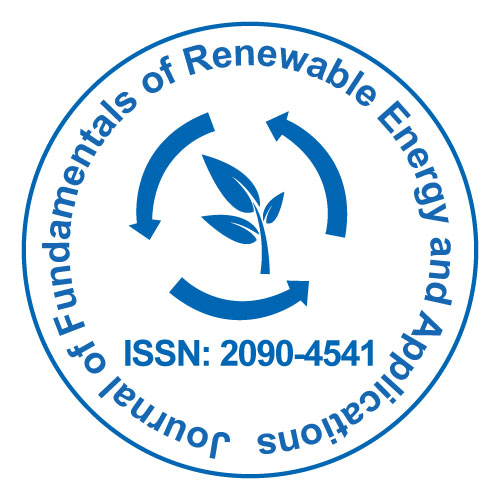
Journal of Fundamentals of Renewable Energy and Applications
Open Access
ISSN: 2090-4541
+44 1300 500008

ISSN: 2090-4541
+44 1300 500008
Short Communication - (2023)Volume 13, Issue 1
Photovoltaics is most widely recognised as a method for producing electric power through the utilisation of solar cells in order to convert solar energy into an electron flow via the photovoltaic effect. Solar cells convert sunlight into direct current electricity that can be used to power devices or recharge batteries. The first practical application of photovoltaics was to power orbiting satellites and other spacecraft, but today the bulk of photovoltaic modules are utilised for gridconnected systems for power generation. In this instance an inverter is necessary to convert the DC to AC. Stand-alone systems for distant residences, boats, recreational vehicles, electric automobiles, roadside emergency telephones, remote sensing, and cathodic protection of pipelines continue to have a lesser market [1-5].
The conversion of light into energy using semiconducting materials that show the photovoltaic effect, a phenomenon investigated in physics, photochemistry, and electrochemistry, is known as photovoltaics (PV). Commercially, the photovoltaic effect is employed to generate power and as photosensors [6].
Decoupled Two different kinds of hybrid solar power systems are photovoltaic and linked PV-CPV/CSP. These are the systems that that integrate both technologies on a single workplace. The second form of hybrid solar system is Photovoltaic Thermal Collector (PVT) or Concentrated Photovoltaic Thermal Collector (CPVT) systems, which combine CPV/PV and CSP into a single system [7,8].
The current study is focused on photovoltaic power generation technology. Photovoltaic technology is classified into two types based on whether or not a concentrator is utilized. In an attempt to provide a clear summary of installed CPV and PV systems around the world, statistics show that, despite the fact that CPV has a better efficiency than PV, the accumulative capacity of CPV mounted globally is minimal. This finding was led by a feasibility examination of CPV large scale facilities and gave unique policy ideas for resolving the problem of high CPV device pricing [9].
In addition, I investigated the soiling issue. The authors analyzed a vast amount of literature on PV soiling measuring methodology, impacts, and cleaning approaches in both Morocco and India, and found that soiling is a highly localized process, with plant position having a significant influence on soiling [10].
The most frequent design of solar photovoltaic systems is a gridconnected PV system, which is utilized when customers wish to lower their energy bills and the grid is available for use when the array PV fails to produce electricity. A "Utility-Interactive PV System" or "Grid Tied PV System" is a PV-array that has a direct link to the grid and does not require a storage system. These Connected Grid PV Systems incorporate solar panels that generate a portion, if not all, of their power needs during the day while remaining connected to the local electrical grid at night. Extra or surplus electricity can be stored in batteries or delivered back into the electrical grid in most connected grid PV setups [11,12].
Solar energy can be used to meet some or all of a person's energy needs if they have a connected grid PV system in their home or building. Furthermore, because this type of PV system is permanently connected to the grid, there will be no need to calculate solar energy consumption or solar panel sizing, allowing for a variety of options, including a system as small as 1.0 kiloWh on the tower to dramatically reduce the electricity bills, and a much larger ground assembled array large enough to completely eliminate the electricity costs. Stand-alone PV systems are equivalent to hybrid PV systems. A hybrid power system's purpose is to produce as much electricity from renewable sources as feasible while satisfying load demand. A hybrid system may include an AC or DC distribution system, a storage system, filters, converters, and a load control or supervisory system, in addition to energy sources. All of these factors are related in various ways.
Citation: Marina M (2023) Performance Optimization and Obstacles of Solar Photovoltaic Energy. J Fundam Renewable Energy Appl. 13:304.
Received: 02-Jan-2023, Manuscript No. JFRA-23-23364; Editor assigned: 06-Jan-2023, Pre QC No. JFRA-23-23364 (PQ); Reviewed: 27-Jan-2023, QC No. JFRA-23-23364; Revised: 03-Feb-2023, Manuscript No. JFRA-23-23364 (R); Published: 10-Feb-2023 , DOI: 10.35248/2090-4541.23.13.304
Copyright: © 2023 Margret M. This is an open-access article distributed under the terms of the Creative Commons Attribution License, which permits unrestricted use, distribution, and reproduction in any medium, provided the original author and source are credited.